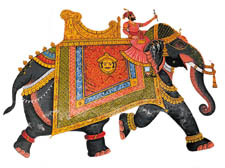|
|
 |
| |

Dragon and elephant illustrations from the dustjacket of the book |
It’s a new dawn for old world powers
The increasing might and importance of China and India are brought to light in David Smith’s book. Review by Dilip Hiro
The Dragon and the Elephant: China, India and the New World Order. By David Smith.
Profile Books £15
IT is conventional wisdom that the 21st century will be the century of Asia. But that would not be something novel, according to this well-argued, meticulously researched book by David Smith, the economics editor of the Sunday Times.
It provides a historical perspective about China and India dating back to medieval times. Six centuries ago the Chinese navy ventured beyond the Indian Ocean, reaching the Red Sea and the coast of Africa.
So, by the time China and India become economic super-powers in around 2050, they will merely re-establish the status quo of 1820, when China accounted for 33 per cent of the world economy and India half as much.
In the final analysis, it all boils down to scale. China and India are mega-nations, together constituting two-fifths of the human race. China’s annual economic growth of nearly 10 per cent over the past quarter century translates into 10 per cent economic expansion for one-and-a-half times the population of Africa’s 52 countries.
China’s economic miracle is the result of rapid industrialisation combined with urbanisation and an overhaul of its banking system.
On the eve of China’s admission to the World Trade Organization in December 2001, its Communist rulers could proudly claim that since 1978, when economic liberalisation got going, the number of Chinese living below the poverty line (defined by the World Bank as those existing on two-thirds of a US dollar a day) had dwindled from 260 million to 42 million in a country of 1,300 million.
During this period, Chinese migrated from villages to urban centres at the annual rate of one per cent of the population. The percentage of the college-age population in higher education jumped from 1.4 per cent to 20 per cent. China boasted 100 million internet users and four times as many mobile phone owners.
On the other hand, the gap between the rich and the poor widened dramatically, and the social welfare system all but vanished.
Urbanisation and industrialisation, coupled with easy loans from banks, fuelled a construction boom – a main ingredient of the economic growth on the domestic front. From power plants to steel mills, and car factories to the relentless expansion of expressways, to high rise office complexes and luxury apartment blocks, the skylines of China’s towns and cities became dotted with construction cranes. In the 1990s China spent an average $33 billion a year on expanding its road network.
In 2002 China became the world’s second largest energy consumer, outstripping Japan. Demand for electric power rocketed as the number of air conditioners rose 50-fold, refrigerators 10-fold and television sets five-fold between 1984 and 2003. There was also an explosion in the construction of new factories which required electricity.
Though car ownership nearly trebled during the decade of 1995-2004, there were only eight cars per 1,000 Chinese people of driving age.
The comparative figure for America is 70 times higher. So the potential for growth was immense.
It is the same with India. Despite a rocketing increase in car purchase, car ownership is only one per cent of what it is in the United States.
When it comes to comparing India with China, even Indian politicians concede that there is no race between the two giant nations: China is too far ahead of India in economic and educational development.
Where India has caught the imagination of the western media is in the field of services – particularly providing staff to man call centres – and information technology (IT). But, as Smith notes, the direct and indirect IT employment covers only one per cent of India’s labour force.
Though 1991 is widely marked as the year when economic liberalisation started
in India, Smith rightly points out an earlier attempt at economic reform in 1985.
Trotting out the recall of J R D Tata, a pre-eminent capitalist, that Prime Minister Jawaharlal Nehru considered profit a dirty word does not square up with the fact the leading Indian business houses bankrolled the nationalist Congress Party of Nehru to end the predominance of the British capital in India and exploit the vast Indian market for their material benefit.
Equally unjustified is the criticism of the Nehru government’s policies of high import tariffs and an import-substitution drive was designed to let the nascent Indian manufacturing industry develop and be able to withstand the blast of foreign competition later.
By the time India opened its doors to foreign multinationals and technology in 1991, its indigenous industry stood on solid foundations and easily absorbed the latest technology and manufacturing methods through joint ventures.
Smith tries to reassure his readers that China and India are “just Japan, Taiwan, and South Korea in another guise. Bigger yes, but similar”.
He adds that “the world is remarkably good at absorbing new arrivals on the global economic scene and benefiting from their presence”.
He fails to delve into economic superpowers’ military ambitions.
Japan’s pacifist constitution limits its armed forces to a strictly defensive role. Taiwan and South Korea are military minnows.
This is not the case with India and China. They possess nuclear weapons. This year China’s defence budget shot up by 18 per cent. And India has already acquired military bases in Tajikistan and Myanmar.
|
 |
|
| |
 |
|
 |
|


